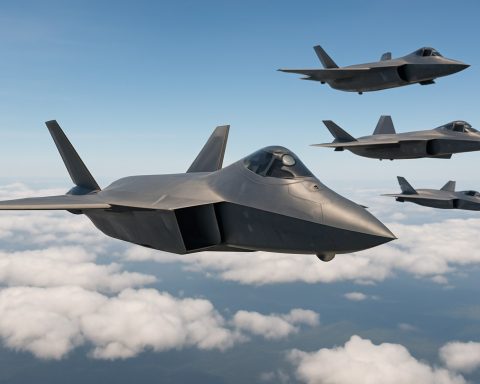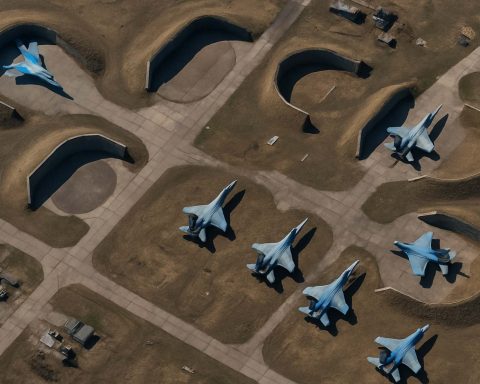- The Israeli Air Force successfully intercepted a rocket launched from the Gaza Strip around 3:58 p.m.
- The Iron Dome missile interception system effectively neutralized the threat, showcasing its precision and speed.
- Residents of Re’im experienced a momentary pause as alarm sirens alerted them to the potential danger.
- This event underscores the continual regional tensions and Israel’s vigilance in maintaining security.
- The interception reflects the ongoing dance between defense strategies and diplomatic efforts for peace.
- The incident highlights challenges in achieving peace and stability in the Middle East.
- The spirit of resilience among residents is a reminder of the pursuit of prolonged harmony despite recurrent threats.
Against the ever-present backdrop of unease, the sky over the Israeli border came alive with electric tension as the Israeli Air Force adeptly intercepted a daring rocket from the Gaza Strip. The clock had barely reached 3:58 p.m. when the sirens blared through the usually quiet community of Re’im, alerting residents to the potential danger hurtling through the atmosphere.
A dramatic arc of defense unfolded as the Iron Dome, Israel’s celebrated missile interception system, roared into action. This resilient network of technology, characterized by its precision and speed, remains a formidable player in a region where peace is often as elusive as the desert mirage. Each successful interception serves as a vivid testament to the relentless pursuit of safety amidst a complex mosaic of regional tensions.
For the people of Re’im, and indeed all within earshot of those ubiquitous alarms, life momentarily paused—a collective intake of breath as the potential for catastrophe soared above. Houses in the impacted area, with their sun-drenched walls now hidden beneath a shadow of uncertainty, stand witness to the resilience ingrained in the fabric of their daily lives.
The rocket interception is more than a mere military engagement; it is a chapter in a larger narrative—one that underscores an enduring dance of defense and diplomacy. Israel, relying on its Iron Dome system, stands ever vigilant, each successful interception rekindling debates about security, human courage, and the intricate dance for peace.
This incident highlights an enduring truth: the quest for peace and stability in the Middle East remains a challenging terrain, punctuated by moments of stark urgency. As technologies advance and strategies evolve, the indefatigable spirit of those living under this shadow is a poignant reminder that beyond each immediate threat, the ultimate aim is achieving prolonged harmony.
In a world constantly pushed by the forces of division and unity, we are reminded of the power of innovation combined with human determination. While the residents of Re’im return to their routines, with children playing and commerce resuming, the story of this interception—a brief moment of action in a perennial cycle—remains etched in both memory and hope.
Breaking Down the Iron Dome: Israel’s Shield in the Sky
Technological Highlights of the Iron Dome
The Iron Dome is a short-range missile defense system that serves as Israel’s frontline defense against rocket attacks. It is renowned for its remarkable efficiency in intercepting and neutralizing incoming threats from areas such as Gaza.
1. Precision and Speed: The system employs advanced radar technology to detect and track rockets immediately upon launch. The data is processed, and the trajectory is evaluated to determine impact zones. This precision allows the Iron Dome to prioritize threats that pose the most danger.
2. Interception Rate: According to various sources, including Rafael Advanced Defense Systems, the developer of the Iron Dome, the system boasts a success rate of over 90% for intercepting targeted projectiles.
3. Components:
– Detection and Tracking Radar: Senses and follows the trajectory of incoming rockets.
– Battle Management and Weapon Control (BMC): Processes radar information and coordinates the interception.
– Missile Firing Unit: Launches the Tamir interceptor missile to neutralize the threat.
Real-World Use Cases
The Iron Dome’s deployment has profound implications in both military and civilian contexts. Each interception prevents potential casualties and property damage, illustrating a broader impact on the volatile landscape in regions experiencing ongoing conflict.
– Cultural and Economic Resilience: The system acts as a stabilizing factor, allowing communities like Re’im to maintain daily routines with a semblance of normalcy despite external threats.
– Diplomatic Tool: Beyond defense, the Iron Dome serves as a strategic asset in negotiations, reflecting the technological prowess and commitment to ensuring the safety of Israeli citizens.
Market Forecasts and Industry Trends
– Expanding Defenses: With the increasing sophistication of airborne threats, defense systems like the Iron Dome are continually evolving. Innovations as part of Israel’s defense initiative focus on increasing range and interception capabilities.
– Global Interest: Nations facing similar threats have shown interest in acquiring or developing comparable systems, underscoring the potential international market for advanced missile defense technologies.
Iron Dome: Pros and Cons Overview
Pros:
– High Success Rate: Its ability to accurately intercept threats significantly reduces civilian casualties.
– Psychological Security: Offers reassurance to residents in affected areas, bolstering public morale and societal stability.
– Adaptability: Continuously updated to counter evolving threats.
Cons:
– Cost: Each interception is expensive, and sustaining the system over prolonged periods can strain defense budgets.
– Limitations: Primarily designed for short-range projectiles, not long-range ballistic missiles.
Addressing Pressing Questions
How Effective Is the Iron Dome in Real Scenarios?
The system has saved countless lives by providing immediate and reliable protection against rocket fire, with decades of operational experience validating its capabilities.
What Are the Long-Term Implications of Its Deployment?
The Iron Dome contributes to regional stability, allowing for economic development and population growth in border areas previously vulnerable to attacks.
Actionable Recommendations
– Stay Informed: For residents in affected regions, knowing how the Iron Dome works can provide a sense of control and preparedness.
– Encourage Innovation: Support government and private sector initiatives aiming to enhance defense systems, ensuring a safer future.
Conclusion
The Iron Dome exemplifies the blend of technology and human resolve in confronting ongoing security threats. It shows the power of innovation in achieving tactical defense while fostering the longer-term dream of peace and stability in a historically tumultuous region.
For more insights into advanced defense systems technology, visit Rafael Advanced Defense Systems.









